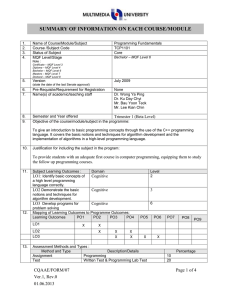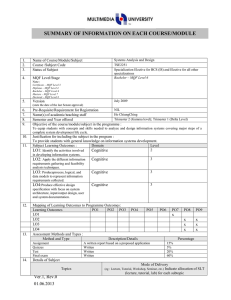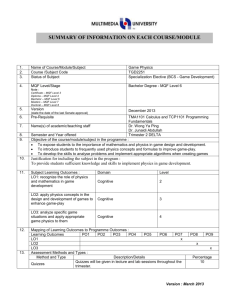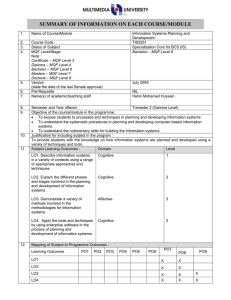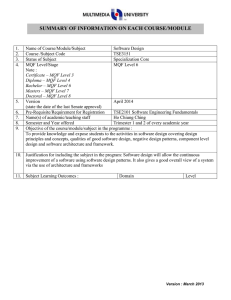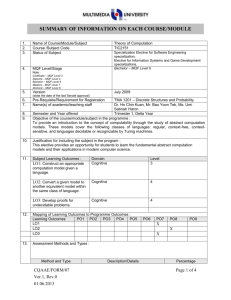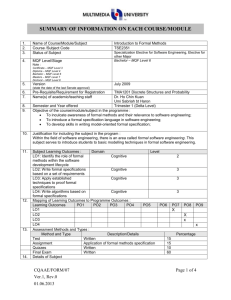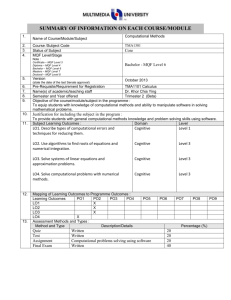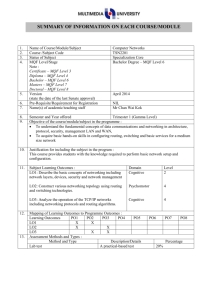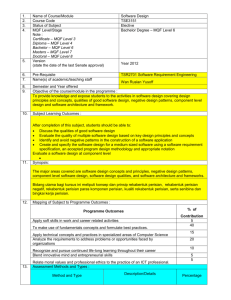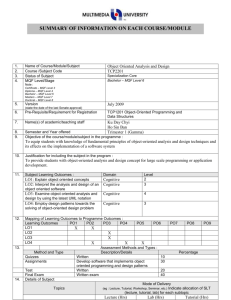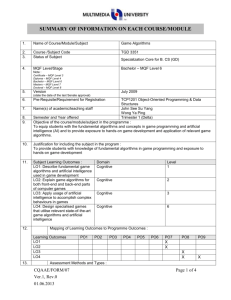Table 3: Summary of information on each course/module
advertisement
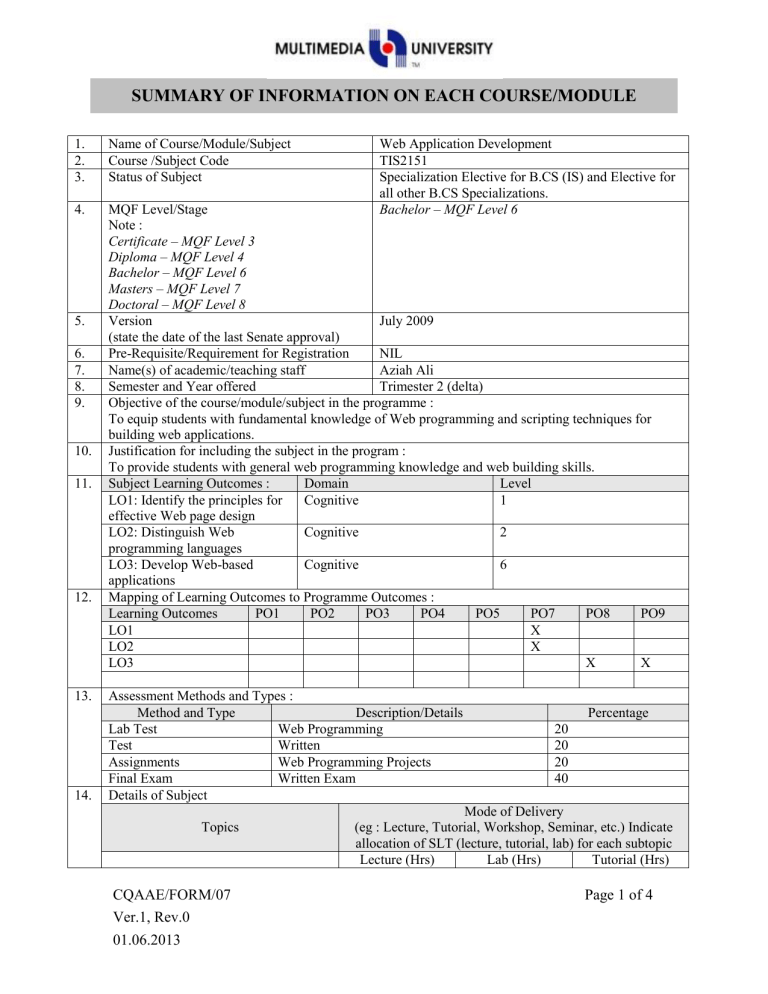
SUMMARY OF INFORMATION ON EACH COURSE/MODULE 1. 2. 3. Name of Course/Module/Subject Course /Subject Code Status of Subject 4. MQF Level/Stage Note : Certificate – MQF Level 3 Diploma – MQF Level 4 Bachelor – MQF Level 6 Masters – MQF Level 7 Doctoral – MQF Level 8 Version July 2009 (state the date of the last Senate approval) Pre-Requisite/Requirement for Registration NIL Name(s) of academic/teaching staff Aziah Ali Semester and Year offered Trimester 2 (delta) Objective of the course/module/subject in the programme : To equip students with fundamental knowledge of Web programming and scripting techniques for building web applications. Justification for including the subject in the program : To provide students with general web programming knowledge and web building skills. Subject Learning Outcomes : Domain Level LO1: Identify the principles for Cognitive 1 effective Web page design LO2: Distinguish Web Cognitive 2 programming languages LO3: Develop Web-based Cognitive 6 applications Mapping of Learning Outcomes to Programme Outcomes : Learning Outcomes PO1 PO2 PO3 PO4 PO5 PO7 PO8 PO9 LO1 X LO2 X LO3 X X 5. 6. 7. 8. 9. 10. 11. 12. 13. 14. Web Application Development TIS2151 Specialization Elective for B.CS (IS) and Elective for all other B.CS Specializations. Bachelor – MQF Level 6 Assessment Methods and Types : Method and Type Description/Details Lab Test Web Programming Test Written Assignments Web Programming Projects Final Exam Written Exam Details of Subject Topics CQAAE/FORM/07 Ver.1, Rev.0 01.06.2013 Percentage 20 20 20 40 Mode of Delivery (eg : Lecture, Tutorial, Workshop, Seminar, etc.) Indicate allocation of SLT (lecture, tutorial, lab) for each subtopic Lecture (Hrs) Lab (Hrs) Tutorial (Hrs) Page 1 of 4 1. Introduction to the World Wide Web Introduction, The evolution of The Internet and World Wide Web, Web basics, Multi-tier Application Architecture, Client-side Scripting vs Server-side Scripting, World Wide Web Consortium (W3C) 2. Introduction to HTML5 Introduction, Editing HTML5, W3C Validation service for HTML5, Headings, Linkings, Images, Lists, Tables, Forms, Meta Elements, HTML5 Form input Types, Datalist Elements and autocomplete Attribute, PageStructure Elements 3. Introduction to Cascading Style Sheets (CSS) Introduction, Inline Styles, Embedded Style Sheets, External Style Sheets, Positioning Elements, Backgrounds, Element Dimensions, Box-model and Text-flow 4. Client-side Scripting: Javascript Introduction, JavaScript Editing, Obtaining user inputs, Memory Concepts, Arithmetic, Equality and Relational Operator, Control statements I : if Statement, if..else Statement & while Statement, Assignment Operators, Increment and Decrement Operators, Control Statements II: for Statement, switch Statement & do..while Statement, Logical Operators, JavaScript Functions, JavaScript Arrays 5. Multimedia: Introduction to Canvas in HTML5 Introduction, canvas Coordinate System, Rectangles, Line drawing, Arcs and Circles, Shadows, Linear Gradients, Radial Gradients, Images, Patterns, Transformations, Text CQAAE/FORM/07 Ver.1, Rev.0 01.06.2013 3 3 0 6 6 0 4 4 0 6 6 0 3 3 0 Page 2 of 4 6. Web servers and Databases: Server-side Scripting Introduction, Accessing Web Servers, Apache, MySQL and PHP Installation, Microsoft IIS, SQL and Microsoft Access Databases, Introduction to PHP, PHP Scripting: Data-types conversion, Arithmetic Operators, Arrays, String Comparisons, Form Processing, Database Access & Cookies, Website Maintenance 15. 16. 17. 6 6 28 28 0 Total Student Face to Face Independent Learning Learning Time (SLT) Lecture 28 28 Tutorials Laboratory/Practical 28 28 Group Project 1 18 Mid Term Test 1 4 Lab Test 1 3 Final Exam 2 18 Sub Total 61 99 Total SLT 160 Credit Value 4 (160 / 40) = 4 Reading Materials : Textbook Reference Materials Deitel, P., Deitel H., & Deitel A. (2012). Internet Sebesta R.W. (2011). Programming the World & World Wide Web: How to Program (5th Wide Web (6th Edition).US: Pearson Edition). England: Pearson CQAAE/FORM/07 Ver.1, Rev.0 01.06.2013 Page 3 of 4 18. Appendix (to be compiled when submitting the complete syllabus for the programme) : 1. Mission and Vision of the University and Faculty 2. Programme Objectives or Programme Educational Objectives 3. Programme Outcomes (POs) 4. Mapping of POs to the 8 MQF domain 5. Mapping of Los to the POs 6. Summary of the Bloom’s Taxonomy’s Domain Coverage in all the Los in the format below : Bloom’s Taxonomy Domain Learning Outcomes Subject (please state the Affective learning 0utcomes) ABC1234 Cognitive Psychomotor Learning Outcome 1 Learning Outcome 2 Learning Outcome 3 Learning Outcome 4 7. Summary of LO to PO measurement 8. Measurement and Tabulation of result for LO achievement 9. Measurement Tabulation of result for PO achievement Mapping Learning Outcome to Assessment No. A1 Assessment Assignments A2 Test 20 A3 Lab test 20 A2 Final Exam 40 CQAAE/FORM/07 Ver.1, Rev.0 01.06.2013 % 20 LO1 X X LO2 X LO3 X X X X X Page 4 of 4
